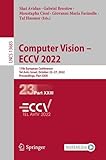Computer Vision - ECCV 2022 [electronic resource] : 17th European Conference, Tel Aviv, Israel, October 23-27, 2022, Proceedings, Part XXIII / edited by Shai Avidan, Gabriel Brostow, Moustapha Cissé, Giovanni Maria Farinella, Tal Hassner.
Contributor(s): Avidan, Shai [editor.] | Brostow, Gabriel [editor.]
| Brostow, Gabriel [editor.] | Cissé, Moustapha [editor.]
| Cissé, Moustapha [editor.] | Farinella, Giovanni Maria [editor.]
| Farinella, Giovanni Maria [editor.] | Hassner, Tal [editor.]
| Hassner, Tal [editor.] | SpringerLink (Online service)
| SpringerLink (Online service) .
.
Material type:  BookSeries: Lecture Notes in Computer Science: 13683Publisher: Cham : Springer Nature Switzerland : Imprint: Springer, 2022Edition: 1st ed. 2022.Description: LVI, 765 p. 254 illus., 245 illus. in color. online resource.Content type: text Media type: computer Carrier type: online resourceISBN: 9783031200502.Subject(s): Computer vision
BookSeries: Lecture Notes in Computer Science: 13683Publisher: Cham : Springer Nature Switzerland : Imprint: Springer, 2022Edition: 1st ed. 2022.Description: LVI, 765 p. 254 illus., 245 illus. in color. online resource.Content type: text Media type: computer Carrier type: online resourceISBN: 9783031200502.Subject(s): Computer visionAccelerating Score-Based Generative Models with Preconditioned Diffusion Sampling -- Learning to Generate Realistic LiDAR Point Clouds -- RFNet-4D: Joint Object Reconstruction and Flow Estimation from 4D Point Clouds -- Diverse Image Inpainting with Normalizing Flow -- Improved Masked Image Generation with Token-Critic -- TREND: Truncated Generalized Normal Density Estimation of Inception Embeddings for GAN Evaluation -- Exploring Gradient-Based Multi-directional Controls in GANs -- Spatially Invariant Unsupervised 3D Object-Centric Learning and Scene Decomposition -- Neural Scene Decoration from a Single Photograph -- Outpainting by Queries -- Unleashing Transformers: Parallel Token Prediction with Discrete Absorbing Diffusion for Fast High-Resolution Image Generation from Vector-Quantized Codes -- ChunkyGAN: Real Image Inversion via Segments -- GAN Cocktail: Mixing GANs without Dataset Access -- Geometry-Guided Progressive NeRF forGeneralizable and Efficient Neural Human Rendering -- Controllable Shadow Generation Using Pixel Height Maps -- Learning Where to Look - Generative NAS Is Surprisingly Efficient -- Subspace Diffusion Generative Models -- DuelGAN: A Duel between Two Discriminators Stabilizes the GAN Training -- MINER: Multiscale Implicit Neural Representation -- An Embedded Feature Whitening Approach to Deep Neural Network Optimization -- Q-FW: A Hybrid Classical-Quantum Frank-Wolfe for Quadratic Binary Optimization -- Self-Supervised Learning of Visual Graph Matching -- Scalable Learning to Optimize: A Learned Optimizer Can Train Big Models -- QISTA-ImageNet: A Deep Compressive Image Sensing Framework Solving ℓq-Norm Optimization Problem -- R-DFCIL: Relation-Guided Representation Learning for Data-Free Class Incremental Learning -- Domain Generalization by Mutual-Information Regularization with Pre-trained Models -- Predicting Is Not Understanding: Recognizing and Addressing Underspecification in Machine Learning -- Neural-Sim: Learning to Generate Training Data with NeRF -- Bayesian Optimization with Clustering and Rollback for CNN Auto Pruning -- Learned Variational Video Color Propagation -- Continual Variational Autoencoder Learning via Online Cooperative Memorization -- Learning to Learn with Smooth Regularization -- Incremental Task Learning with Incremental Rank Updates -- Batch-Efficient EigenDecomposition for Small and Medium Matrices -- Ensemble Learning Priors Driven Deep Unfolding for Scalable Video Snapshot Compressive Imaging -- Approximate Discrete Optimal Transport Plan with Auxiliary Measure Method -- A Comparative Study of Graph Matching Algorithms in Computer Vision -- Improving Generalization in Federated Learning by Seeking Flat Minima -- Semidefinite Relaxations of Truncated Least-Squares in Robust Rotation Search: Tight or Not -- Transfer without Forgetting -- AdaBest: Minimizing Client Drift in Federated Learning via Adaptive Bias Estimation -- Tackling Long-Tailed Category Distribution under Domain Shifts -- Doubly-Fused ViT: Fuse Information from Vision Transformer Doubly with Local Representation.
The 39-volume set, comprising the LNCS books 13661 until 13699, constitutes the refereed proceedings of the 17th European Conference on Computer Vision, ECCV 2022, held in Tel Aviv, Israel, during October 23-27, 2022. The 1645 papers presented in these proceedings were carefully reviewed and selected from a total of 5804 submissions. The papers deal with topics such as computer vision; machine learning; deep neural networks; reinforcement learning; object recognition; image classification; image processing; object detection; semantic segmentation; human pose estimation; 3d reconstruction; stereo vision; computational photography; neural networks; image coding; image reconstruction; object recognition; motion estimation.


There are no comments for this item.